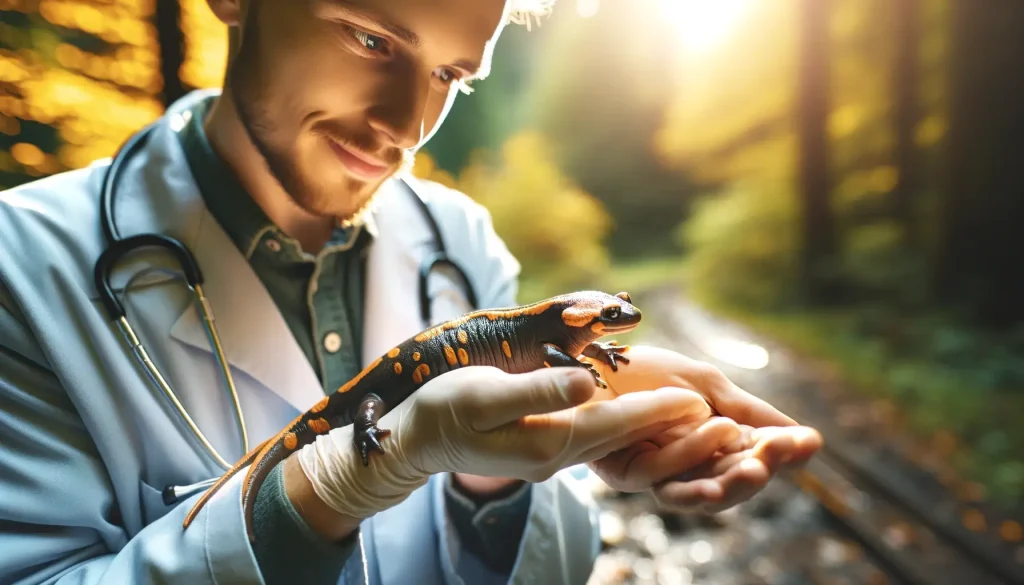
US Pet Salamanders Are Bsal-Free
A recent U.S. survey focused on pet salamanders has brought us some good news. The study, aimed at detecting the presence of two major fungal pathogens, has found no trace of the Batrachochytrium salamandrivorans (Bsal) pathogen. This comes as a relief to salamander enthusiasts and conservationists alike. The pathogens in question, Bsal and Batrachochytrium dendrobatidis (Bd), are known for their detrimental effects on amphibian populations worldwide.
Engaging the pet salamander community, the study provided owners with kits to safely test their pets for the pathogens. A significant effort, considering the diversity and number of participants involved. Overall, 639 samples were collected across 65 species, covering a wide genetic canvas of the salamander family. Despite the breadth of this study, Bsal remained undetected, suggesting its absence or extremely low presence in the U.S. pet population.
The undertaking was not just about detection; it was a preventive measure against a potentially devastating ecological threat. The United States Fish and Wildlife Service had previously listed 201 species of salamanders as “injurious wildlife,” severely limiting their import to prevent Bsal’s introduction. The results justify these precautions and stress the importance of continued vigilance.
Pet Salamander Health FAQs
Understanding the health and safety of pet salamanders is essential for all pet owners. Here, we address common questions based on the recent U.S. survey finding no Bsal pathogen in pet salamanders.
What is Bsal?
Bsal, or Batrachochytrium salamandrivorans, is a fungal pathogen that poses a significant threat to salamander populations. It’s responsible for severe skin diseases in amphibians, particularly salamanders.


Why was this survey conducted?
The survey aimed to detect the presence of Bsal and Bd (Batrachochytrium dendrobatidis) in U.S. pet salamanders. Researchers provided pet owners with kits to test their pets safely, preventing the potential spread of these pathogens.
What were the key findings?
A key finding from the survey was the non-detection of Bsal in the sampled population of pet salamanders. Only 1.3% showed presence of Bd. This suggests a very low or non-existent presence of Bsal in the U.S.
How many samples were collected, and from how many species?
A total of 639 samples were collected from 65 species of salamanders, across 22 genera and three families. This wide coverage ensures the study’s comprehensive nature.
What implications do these findings have?
The non-detection of Bsal is significant. It suggests that measures taken to prevent Bsal’s introduction, like the 2016 Lacey Act amendment, have been effective. Yet, continued vigilance and preventive measures are advised to keep Bsal out of the U.S.
What precautions can pet owners take?
Pet owners should practice good hygiene, regularly sanitize their hands before and after handling their pets, and avoid introducing wild amphibians to their home environment. Importantly, consult a veterinarian if their pet shows signs of illness.
Will the testing for pathogens continue?
Yes, ongoing monitoring and testing for both Bsal and Bd are recommended. These pathogens‘ situations can change, and continuous efforts are crucial in preventing their spread.

Fun Facts About Pet Salamanders
Salamanders are fascinating creatures, and pet salamander owners know this all too well. Here are some fun facts that every salamander enthusiast should know.
- Salamanders are ancient: These intriguing amphibians date back over 200 million years, making them some of the planet’s oldest inhabitants.
- Diverse family: There are approximately 500 species of salamanders across the globe, fitting into various ecological niches.
- Masters of regeneration: Salamanders are known for their impressive ability to regenerate lost limbs, as well as other body parts, including hearts, intestines, and even parts of their brains.
- They breathe through their skin: Most salamanders lack lungs and instead absorb oxygen directly through their skin, requiring them to live in damp or aquatic environments to breathe effectively.
- Unique communication: Unlike many pets that vocalize, salamanders are mostly silent creatures and rely on body language and pheromones to communicate with one another.
- Variety of diets: Depending on the species, a salamander’s diet can range widely from insects and worms to small fish. Pet owners often feed them crickets, mealworms, and brine shrimp.
- Temperature-sensitive: Salamanders are ectothermic (cold-blooded), meaning their body temperature is regulated by the environment. This makes maintaining a specific temperature range critical in captivity.
- Long-lived pets: With proper care, some species of salamanders can live up to 20 years in captivity, making them long-term companions for enthusiasts.
These facts not only shed light on the unique nature of salamanders but also underscore the importance of proper care and conservation efforts. Engaging in studies and surveys, like the recent one that found no Bsal pathogen in US pet salamanders, helps protect these ancient and diverse creatures.

Bsal Prevention
In response to the rising concern about the introduction of Batrachochytrium salamandrivorans (Bsal) into the United States, significant measures have been taken. The United States Fish and Wildlife Service made a strategic move by listing 201 species of salamanders as “injurious wildlife” under the Lacey Act. This was a precautionary action aimed at preventing the importation of potentially Bsal-infected salamanders.
The impact of this listing was profound, reducing the number of salamanders imported into the U.S. from 2015 to 2016 by 98.4%. Such a drastic decrease underscores the effectiveness of the regulation in curtailing the risk of Bsal entering the U.S., a country known for its rich salamander biodiversity. This biodiversity is crucial not only for ecological balance but also for research and educational purposes.
The non-detection of Bsal in the recent survey further validates the precautionary measures taken. Nonetheless, it also emphasizes the importance of continuous vigilance. Pet salamander owners are encouraged to remain cautious. Best practices include maintaining good hygiene when handling pet salamanders, avoiding the introduction of wild amphibians into the same environment as pets, and consulting a veterinarian at any sign of illness.
Given the low prevalence of Batrachochytrium dendrobatidis (Bd), detected in only 1.3% of the samples, it’s clear that while Bd is present, it is not widespread among U.S. pet salamanders. This provides a slightly reassuring aspect for pet owners but again highlights the need for ongoing surveillance and precautionary behavior.
The collaborative effort between pet owners, conservationists, and the scientific community is key to preventing the spread of both Bsal and Bd. Regular testing and reporting are vital components of this collective approach. Such actions not only help safeguard the health of pet salamanders but also protect native populations from potential threats.
Beginner Guide to Raising Quail at Home
What are the Signs of a Dog Concussion?
What Causes Your Dog’s Ears to Smell Bad?
When your dog’s ears start to emit an unpleasant odor, it might leave you puzzled…
Methimazole Treatment for Cat Hyperthyroidism
Methimazole plays a crucial role in managing feline hyperthyroidism, a condition marked by an overactive…
Got Hummingbirds in your Backyard? Here’s How to Care for Them.
Why Does Your Cat Pee Outside the Litter Box?
Cat’s Litter Box Issues It’s not uncommon for cat owners to face the frustrating dilemma…




